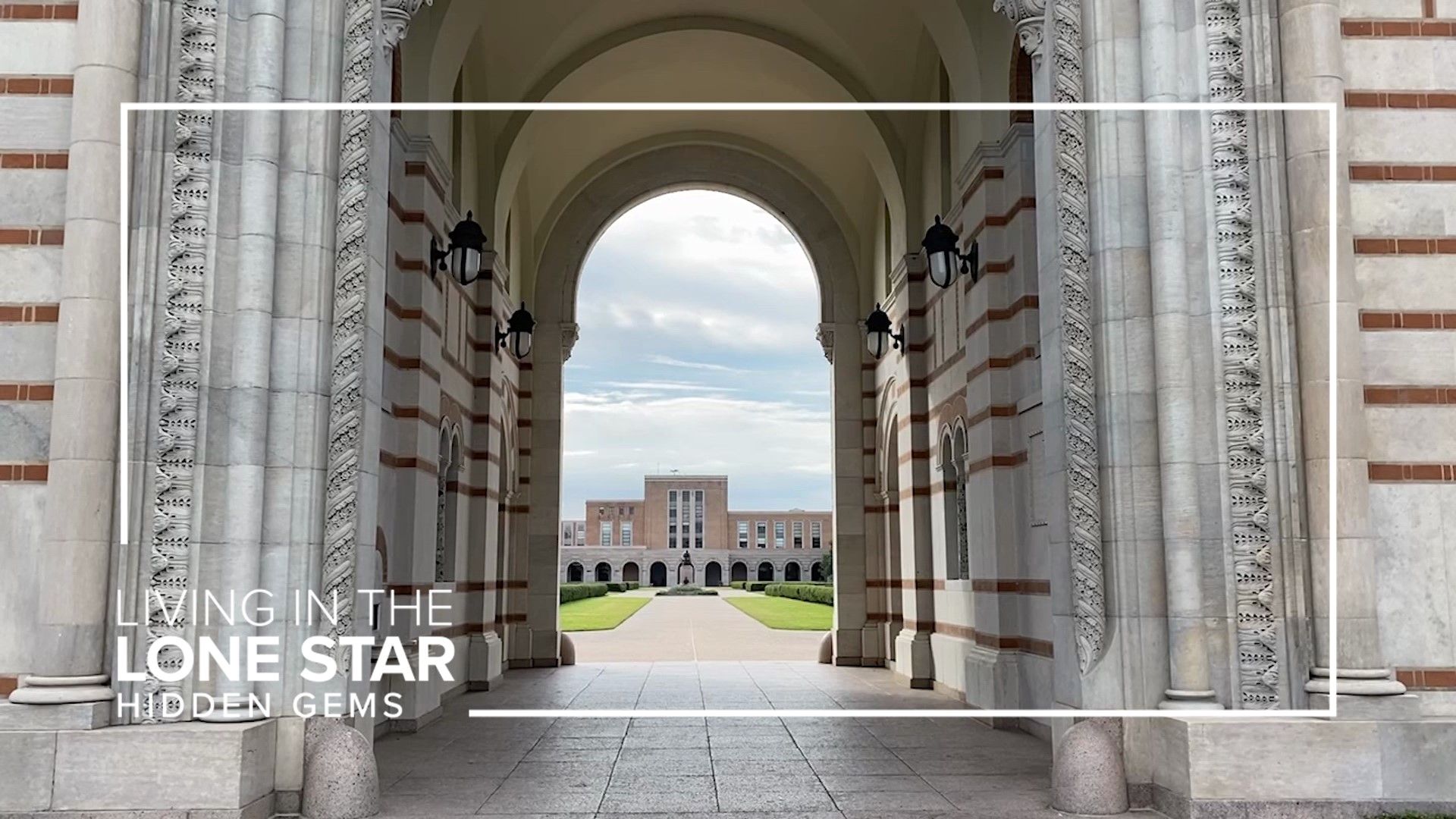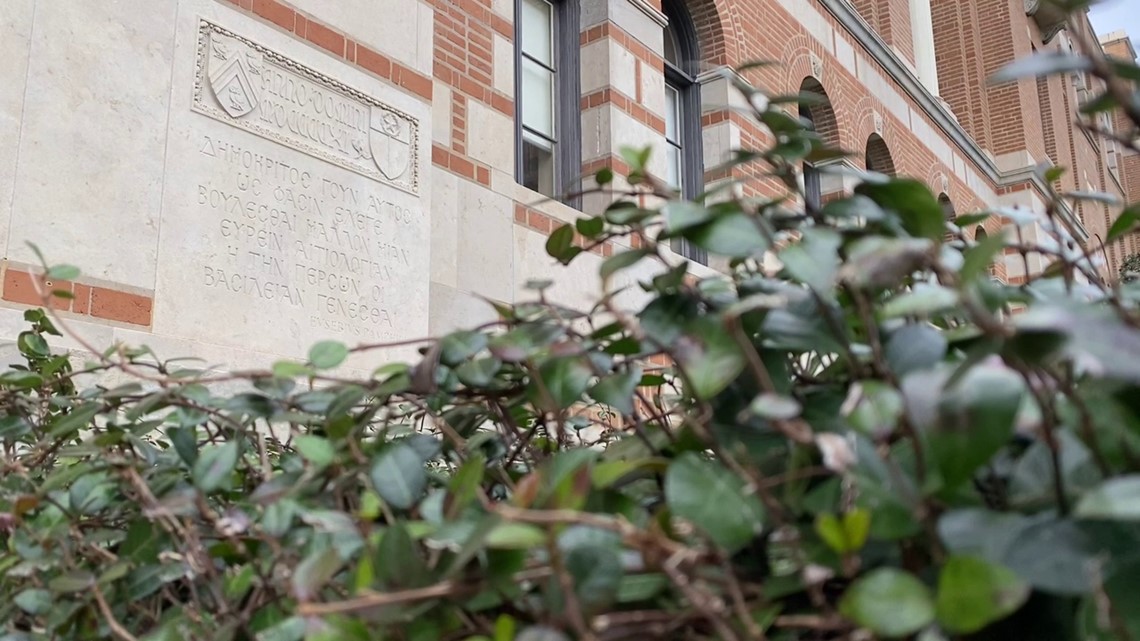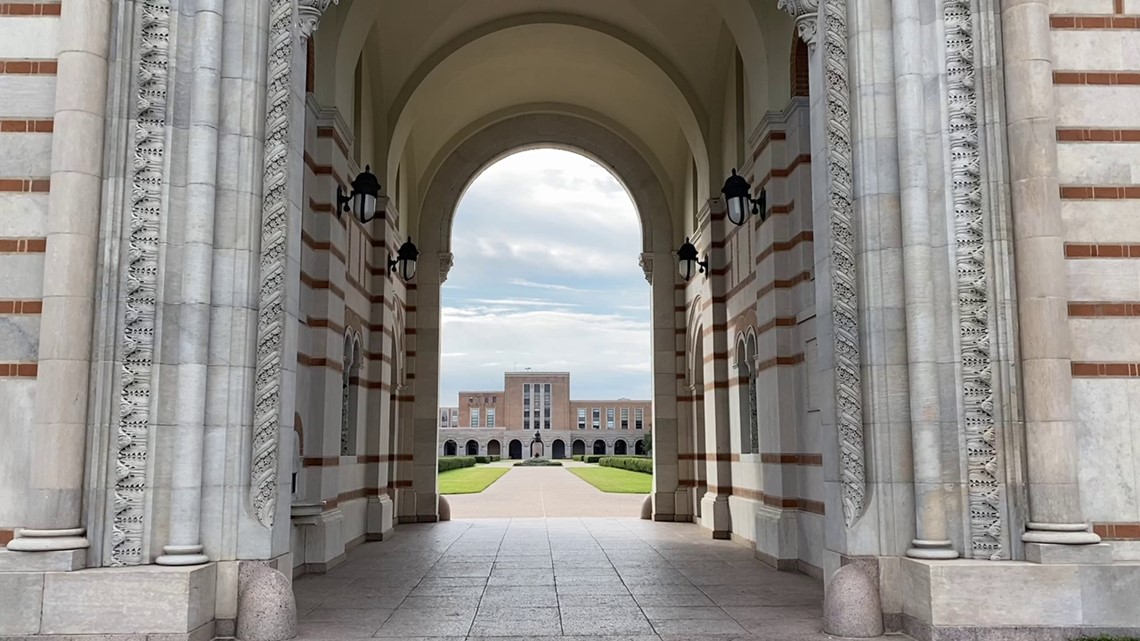HIDDEN GEM: Rice University secrets
Opened in 1912, the Houston campus is loaded with details like a recipe for gold, a resting spaceship and a building that croaks like a frog.

Where in Houston can you find a recipe for gold, a resting spaceship and a building that croaks like a frog? Believe it or not, all of that and so much more is at Rice University.
"We hear a lot of people say, ‘This is what I thought a college should look like,’" shared Greg Marshall.
He knows this campus in and out, first exploring it as a student and now as the university's director of community relations.
"I get to welcome people to Rice," Marshall said, adding that he will celebrate 30 years with the university this year.
Who better to guide KHOU 11 on a tour of Rice's secrets?
Lovett Hall Cornerstone hints at Houston history
Let’s start at the beginning: what is now called Lovett Hall.
"It’s the first building built on the Rice campus," says Marshall.
At the time, President Edgar Odell Lovett knew a new university would be a hard sell. This was the early 1900s when only 9 percent of Americans even graduated from high school.
"To that he decided, it would be helpful if he had really grand architecture and architecture that really spoke to the aspirations he had," Marshall said.
Visitors to the campus might miss the iconic cornerstone installed just right of the building's archway.
"The cornerstone went in on the 75th anniversary of Texas Independence Day," said Marshall.
Along with an inscription, it includes two coats of arms: one for Texas, one for Rice University. The Rice seal was designed by Pierre de Chaignon la Rose, who examined the arms of families with the last name "Rice" or "Houston." He found they all included three birds, as well as a chevron.
"[Rice] decided they would use an owl, representing wisdom, and the specific owl, which is that unusual-looking one with daisy-looking eyes, is from a 5th-century BCD tetradrachmenon coin," Marshall says.


Hidden faces Be sure to check the detailed stonework
The focal point of Lovett Hall is its archway, called the Sallyport. You could spend a whole day studying the detailed stonework, which was all done by one man: Oswald Lassig.
"He came to Houston in 1910 from Germany to bring his old-world tradition of beautiful stone carving to this project," Marshall says.
Lassig added four faces, known as the freshman, sophomore, junior and senior, to the Sallyport and carved other faces, such as Christopher Columbus and Thomas Jefferson, into decorative columns.
He’s also responsible for a series of carvings that connect Lovett Hall to Herzstein Hall.


"This is a 1914 building," Marshall says, gesturing toward Herzstein hall. "The one that faces it that looks like it matches it is a 1970s – seven, zero – building."
The quality of the stone carving is really the only way to tell the difference between Herzstein and its decades-younger mirror Sewall Hall. The efforts to make the two look similar extended as far as reopening the quarry from which Herzstein Hall's green marble came. It had been closed for years.
(This isn’t really a hidden gem, but it is another interesting detail. All the bricks used on Rice buildings come from the same quarry in Louisiana and this is known as the “Rice palette.” The vibrant reds and oranges aren't painted; those are the natural colors.)
The turrets also match, though Marshall pointed out that Sewall’s don’t do anything. Herzstein’s turrets cover fume hoods that vent the chemistry labs.
"Rice has a habit of putting things that are necessary under a lot of beautiful ornament," he says.
Frog Hall Of course kids would figure this out
Just down the courtyard is Anderson Hall. If you’ve ever taken a tour of the university, you’ve probably made a stop at the so-called “frog wall.”
"When it was built they decided they would have a little decorative frieze on the side of the door. It’s got a series of nicely drilled neat holes," Marshall said. "Students came along and realized if you ran your finger down the holes, it makes kind of a Bronx cheer kind of sound."
Or, he added, he might sound like the frogs that are rumored to have called that part of campus home back when it was just an open lawn that sometimes filled with rainwater during Houston storms.


Science, symbols and space
From making sound to making gold, there's a hidden element on Keck Hall. Just above one of its doors, there is an enigma, a kind of riddle used by alchemists, that purports to decree the recipe to make gold.
The other side of the building is loaded with alchemy and astrology symbols, but a few columns are dotted with inside jokes.
Symbols are also an important feature on nearby Duncan Hall. Built in 1996, the architect described his idea for the home of the Rice University Electrical and Computer Engineering program as a spaceship, just touched down, but ready to take off at any moment.
It’s definitely out of this world. One of the many buildings on the Rice University campus loaded with stories and secrets.
"People are very attached to the architecture," explained Marshall.
You can check all of this out yourself. The campus is open to the public.

